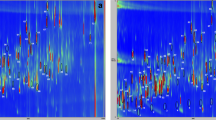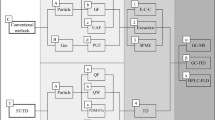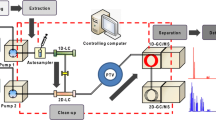Abstract
Landfilling, a traditional and major method for municipal solid waste management, is gradually being taken place by incineration. However, the contamination problem caused by polychlorinated dibenzo-p-dioxin and dibenzofuran (PCDD/F) emissions from incineration has also brought much concerns. Traditional offline method based on high-resolution gas chromatography coupled with high-resolution mass spectrometry for the determination of PCDD/F emissions is expensive, infrequent and time-lagging. Use of PCDD/F indicators to achieve fast indirect measurements for PCDD/Fs is a much more promising method. Six categories of potential PCDD/F indicators are discussed in this paper: CO, total hydrocarbons, specific PCDD/F congeners, polycyclic aromatic hydrocarbons, chlorophenols and chlorobenzenes. Their performance as PCDD/F indicators are verified in the following criteria: (1) structural similarities; (2) known mechanistic arguments; (3) known correlation values from the literature and (4) detectability. Comprehensively considering the four factors, chlorobenzenes may be the best suitable PCDD/F indicator. One analytical method based on Photon Ionization coupled with Time-of-Flight Mass Spectrometry has been proved effective for the online/atline measurements for PCDD/F indicators for the prediction of TEQ in incineration process. Moreover, thermal desorption and gas chromatography can be applied to provide extra separation and concentration for very complex matrices with extremely low concentrations.



Similar content being viewed by others
Change history
27 August 2021
A Correction to this paper has been published: https://doi.org/10.1007/s42768-021-00078-9
References
U. S. EPA. Municipal solid waste generation, recycling, and disposal in the United States tables and figures for 2012. 2014.
European Environment Agency. Managing municipal solid waste—a review of achievements in 32 European countries. EEA Report, No. 2/2013.
China Statistical Yearbook 2008 (Ed.). National Bureau of Statistics of China. Beijing: China Statistics Press; 2009.
China Statistical Yearbook 2016 (Ed.). National Bureau of Statistics of China. Beijing: China Statistics Press; 2017.
Batinic B, Vukmirovic S, Vujic G, Stanisavljevic N, Ubavin D, Vukmirovic G. Using ANN model to determine future waste characteristics in order to achieve specific waste management targets -case study of Serbia. J Sci Ind Res. 2011;70(7):513–8.
Beigl P, Lebersorger S, Salhofer S. Modelling municipal solid waste generation: a review. Waste Manag. 2008;28(1):200–14.
Dyson B, Chang N-B. Forecasting municipal solid waste generation in a fast-growing urban region with system dynamics modeling. Waste Manag. 2005;25(7):669–79.
Intharathirat R, Abdul Salam P, Kumar S, Untong A. Forecasting of municipal solid waste quantity in a developing country using multivariate grey models. Waste Manag. 2015;39:3–14.
Chen XD, Geng Y, Fujita T. An overview of municipal solid waste management in China. Waste Manag. 2010;30(4):716–24.
Karak T, Bhagat RM, Bhattacharyya P. Municipal solid waste generation, composition, and management: the world scenario. Crit Rev Environ Sci Technol. 2011;42(15):1509–630.
McKay G. Dioxin characterisation, formation and minimisation during municipal solid waste (MSW) incineration: review. Chem Eng J. 2002;86(3):343–68.
Brunner CR. Hazardous Waste Incineration. 2nd ed. New York: McGraw-Hill; 1994.
Kim SH, Ahn S-Y, Kwak S-Y. Suppression of dioxin emission in incineration of poly(vinyl chloride) (PVC) as hybridized with titanium dioxide (TiO2) nanoparticles. Appl Catal B. 2008;79(3):296–305.
Olie K, Vermeulen PL, Hutzinger O. Chlorodibenzo-p-dioxins and chlorodibenzofurans are trace components of fly ash and flue gas of some municipal incinerators in The Netherlands. Chemosphere. 1977;6(8):455–9.
Liu H, Kong S, Liu Y, Zeng H. Pollution control technologies of dioxins in municipal solid waste incinerator. Procedia Environ Sci. 2012;16:661–8.
Mukherjee A, Debnath B, Ghosh SK. A review on technologies of removal of dioxins and furans from incinerator flue gas. Procedia Environ Sci. 2016;35:528–40.
Zhou H, Meng A, Long Y, Li Q, Zhang Y. A review of dioxin-related substances during municipal solid waste incineration. Waste Manag. 2015;36:106–18.
Cheng H, Hu Y. Curbing dioxin emissions from municipal solid waste incineration in China: re-thinking about management policies and practices. Environ Pollut. 2010;158(9):2809–14.
Kulkarni PS, Crespo JG, Afonso CAM. Dioxins sources and current remediation technologies—a review. Environ Int. 2008;34(1):139–53.
U.S. EPA. Exposure and human health reassessment of 2,3,7,8-tetrachlorodibenzo-p-dioxin (Tcdd) and Related Compounds National Academy Sciences (External Review Draft) (2004). Washington, D.C.: EPA/600/P-00/001Cb; 2004.
Stockholm Convention on Persistent Organic Pollutants. https://en.wikipedia.org/wiki/Stockholm_Convention_on_Persistent_Organic_Pollutants.
Nganai S, Dellinger B, Lomnicki S. PCDD/PCDF ratio in the precursor formation model over CuO surface. Environ Sci Technol. 2014;48(23):13864–70.
Ambient air and waste gas determination of polychlorinated dibenzo-p-dioxins (PCDDs) and polychlorinated dibenzofurans (PCDFs) isotope dilution HRGCHRMS, issued by Ministry of Environmental Protection of the People’s Republic of China, HJ 77.2-2008, 2008.
Standard for pollution control on the municipal solid waste incineration, issued by Ministry of Environmental Protection of the People’s Republic of China, GB 18485-2014; 2014.
U.S. EPA. Emission guidelines for existing small municipal waste combustion units; final rule; 40 CFR Part 60; 2000.
U.S. EPA. New source performance standards for new small municipal waste combustion units; final rule, 40 CFR Part 60; 2000.
U.S. EPA. Standards of performance for new stationary sources and emission guidelines for existing sources: large municipal waste combustors; final rule, 40 CFR Part 60; 2006.
Environment Agency of Japan. Law concerning special measures against dioxins, Law No. 105 of 1999; 1999.
European Committee for Standardization, EN-1948 Parts 1,2,3. European standard, stationary source emissions. Determination of the mass concentration of PCDDs/PCDFs and dioxin-like PCBs; 2006.
Japanese Standards Association. Method for determination of tetra-through octachlorodibenzo-p-dioxins, tetra-through octachlorodibenzofurans and dioxin-like polychlorinatedbiphenyls in stationary source emissions (Amendment 1), JIS K0311-2008; 2005.
U.S. EPA. Method 23—determination of polychlorinated dibenzo-p-dioxins and polychlorinated dibenzofurans from stationary sources; 2017.
Wang LC, Hsi HC, Chang JE, Yang XY, Chang-Chien GP, Lee WS. Influence of start-up on PCDD/F emission of incinerators. Chemosphere. 2007;67(7):1346–53.
Šyc M, Fišerová E, Karban J, Punčochář M, Pekárek V. The effect of transient operations on the levels and congener profiles of PCBz, PCPh and PCDD/F in raw flue gases of MSWI plant. Chemosphere. 2015;118:261–7.
Lin SL, Wang LC, Kuo YM, Tsai CH, Chang-Chien GP, Reinmann J. Memory effect on PCDD/F sampling by utilizing adsorption method for sampling of dioxin (AMESA) in various sources. Organohalogen Compd. 2012;74:80–4.
Gullett BK, Oudejans L, Tabor D, Touati A, Ryan S. Near-real-time combustion monitoring for PCDD/PCDF indicators by GC–REMPI–TOFMS. Environ Sci Technol. 2012;46(2):923–8.
Streibel T, Zimmermann R. Resonance-enhanced multiphoton ionization mass spectrometry (REMPI-MS): applications for process analysis. Annu Rev Anal Chem (Palo Alto Calif) 2014;7:361–81. https://doi.org/10.1146/annurev-anchem-062012-092648
Öberg T, Bergström JGT. Hexachlorobenzene as an indicator of dioxin production from combustion. Chemosphere. 1985;14(8):1081–6.
Öberg T, Bergström JGT. Emission and chlorination pattern of PCDD/PCDF predicted from indicator parameters. Chemosphere. 1987;16(6):1221–30.
Lenoir D, Kaune A, Hutzinger O, Mützenich G, Horch K. Influence of operating parameters and fuel type on PCDD/F emissions from a fluidized bed incinerator. Chemosphere. 1991;23(8):1491–500.
Finklestein A, Klicius RD. National incinerator testing and evaluation program: the environmental characterization of refuse-derived fuel (RDF) Combustion Technology, Mid-Connecticut Facility, Hartford, Connecticut. Final report, June 1987–March 1993; EPA-600/R-94-140 [PB-96-153432]; U.S. EPA; 1994.
Cains PW, Dyke P. Chlorinated dibenzodioxin and dibenzofuran emissions from waste combustion plants in the UK. Chemosphere. 1994;28(12):2101–19.
Kaune A, Lenoir D, Nikolai U, Kettrup A. Estimating concentrations of polychlorinated dibenzo-p-dioxins and dibenzofurans in the stack gas of a hazardous waste incinerator from concentrations of chlorinated benzenes and biphenyls. Chemosphere. 1994;29(9):2083–96.
Gullett BK, Wikström E. Mono- to tri-chlorinated dibenzodioxin (CDD) and dibenzofuran (CDF) congeners/homologues as indicators of CDD and CDF emissions from municipal waste and waste/coal combustion. Chemosphere. 2000;40(9–11):1015–9.
Blumenstock M, Zimmermann R, Schramm KW, Kettrup A. Identification of surrogate compounds for the emission of PCDD/F (I-TEQ value) and evaluation of their on-line real-time detectability in flue gases of waste incineration plants by REMPI–TOFMS mass spectrometry. Chemosphere. 2001;42(5–7):507–18.
Oh J-E, Gullett B, Ryan S, Touati A. Mechanistic relationships among PCDDs/Fs, PCNs, PAHs, ClPhs, and ClBzs in municipal waste incineration. Environ Sci Technol. 2007;41(13):4705–10.
Wang T, Chen T, Lin B, Lin X, Zhan M, Li X. Emission characteristics and relationships among PCDD/Fs, chlorobenzenes, chlorophenols and PAHs in the stack gas from two municipal solid waste incinerators in China. RSC Adv. 2017;7(70):44309–18.
Watanabe N, Kawamoto K, Asada S, Fujiyoshi H, Miyata H, Watanabe G, Suzuki S. Surrogate study for dioxins from municipal waste incinerator in startup condition: applicability as a dioxin control indicator and an organohalogen emission warning. J Mater Cycles Waste Manag. 2010;12(3):254–63.
Addink R, Cnubben PAJP, Olie K. Formation of polychlorinated dibenzo-p-dioxins/dibenzofurans on fly ash from precursors and carbon model compounds. Carbon. 1995;33(10):1463–71.
Lemieux PM. The use of surrogate compounds as indicators of PCDD/F concentrations in combustor stack gases. New York: Environmental Protection Agency; 2004.
Weber R, Sakurai T, Ueno S, Nishino J. Correlation of PCDD/PCDF and CO values in a MSW incinerator—indication of memory effects in the high temperature/cooling section. Chemosphere. 2002;49(2):127–34.
Liu W, Tian Z, Li H, Xie H, Xiao K, Li C, Tang C, Zheng M. Mono- to Octa-Chlorinated PCDD/Fs in stack gas from typical waste incinerators and their implications on emission. Environ Sci Technol. 2013;47(17):9774–80.
Chachignon M, Leroy G, Manciot F, Chaucherie X, Nicol F. Identification of key surrogates for real-time dioxins monitoring. Organohalogen Compd. 2007;69:1289–92.
Cao X, Ji L, Lin X, Stevens WR, Tang M, Shang F, Tang S, Lu S. Comprehensive diagnosis of PCDD/F emission from three hazardous waste incinerators. R Soc Open Sci. 2018;5(7):172056.
Fullana A, Sidhu SS. Fate of PAHs in the post-combustion zone: partial oxidation of PAHs to dibenzofuran over CuO. J Anal Appl Pyrol. 2005;74(1):479–85.
Weber R, Iino F, Imagawa T, Takeuchi M, Sakurai T, Sadakata M. Formation of PCDF, PCDD, PCB, and PCN in de novo synthesis from PAH: mechanistic aspects and correlation to fluidized bed incinerators. Chemosphere. 2001;44(6):1429–38.
Wikström E, Marklund S. Secondary formation of chlorinated dibenzo-p-dioxins, dibenzofurans, biphenyls, benzenes, and phenols during MSW combustion. Environ Sci Technol. 2000;34(4):604–9.
Dyke PH, Foan C, Fiedler H. PCB and PAH releases from power stations and waste incineration processes in the UK. Chemosphere. 2003;50(4):469–80.
Yan M, Li X, Zhang X, Liu K, Yan J, Cen K. Correlation between PAHs and PCDD/Fs in municipal solid waste incinerators. J Zhejiang Univ (Eng Sci). 2010;44:1118–21.
Blumenstock M, Zimmermann R, Schramm KW, Kettrup A. Influence of combustion conditions on the PCDD/F-, PCB-, PCBz- and PAH-concentrations in the post-combustion chamber of a waste incineration pilot plant. Chemosphere. 2000;40(9):987–93.
Xiao-Dong L, Xue-Feng Y, Sheng-Yong L, Yue-Ling G, Jian-Hua Y, Ming-Jiang N, Ke-Fa C. The correlation between PAHs and dioxins formation during coal and municipal solid waste co-incineration process. Eng Thermophys. 2006;27:691–4.
Pan W, Zhang D, Han Z, Zhan J, Liu C. New insight into the formation mechanism of PCDD/Fs from 2-chlorophenol precursor. Environ Sci Technol. 2013;47(15):8489–98.
Xu F, Yu W, Zhou Q, Gao R, Sun X, Zhang Q, Wang W. Mechanism and direct kinetic study of the polychlorinated dibenzo-p-dioxin and dibenzofuran formations from the radical/radical cross-condensation of 2,4-dichlorophenoxy with 2-chlorophenoxy and 2,4,6-trichlorophenoxy. Environ Sci Technol. 2011;45(2):643–50.
Ghorishi SB, Altwicker ER. Rapid formation of polychlorinated dioxins/furans during the heterogeneous combustion of 1,2-dichlorobenzene and 2,4-dichlorophenol. Chemosphere. 1996;32(1):133–44.
Oh J-E, Gullett B, Ryan S, Touati A. Chlorobenzenes, chlorophenols, PAHs and low chlorinated dioxin/furan as post-boiler toxicity indicators in municipal solid waste incinerators. Organohalogen Compd. 2004;66:764–9.
Yan M. Inhibition of PCDD/Fs formation during medical waste incineration and research of environmental impact of incinerator. Doctoral thesis at Zhejiang University; 2012.
Guo Y. Study on emission characteristics and detection of PCDD/Fs and environment persistent free radicals during solid waste disposal. Master thesis at Zhejiang University; 2014.
Chen T, Gu Y, Yan J, Li X, Lu S, Cen K. Formation of Polychlorinated dibenzo-p-dioxins and dibenzofurans on chlorobenzene and fly ash. J Combust Sci Technol. 2006;12(3):253–6.
Alderman SL, Farquar GR, Poliakoff ED, Dellinger B. An infrared and x-ray spectroscopic study of the reactions of 2-chlorophenol, 1,2-dichlorobenzene, and chlorobenzene with model CuO/silica fly ash surfaces. Environ Sci Technol. 2005;39(19):7396–401.
Nganai S, Lomnicki SM, Dellinger B. Formation of PCDD/Fs from the copper oxide-mediated pyrolysis and oxidation of 1,2-dichlorobenzene. Environ Sci Technol. 2011;45(3):1034–40.
Lavric ED, Konnov AA, Ruyck JD. Surrogate compounds for dioxins in incineration. A review. Waste Manag. 2005;25(7):755–65.
Yoneda K, Ikeguchi T, Yagi Y, Tamade Y, Omori K. A research on dioxin generation from the industrial waste incineration. Chemosphere. 2002;46(9):1309–19.
Kato M, Urano K. Convenient substitute indices to toxic equivalent quantity for controlling and monitoring dioxins in stack gas from waste incineration facilities. Waste Manag. 2001;21(1):55–62.
Kaune A, Lenoir D, Nikolai U. Estimating toxicity equivalents in the stack gas of a hazardous waste incinerator from the concentrations of chlorinated benzenes and biphenyls. Organohalogen Compd. 1993;12:39–42.
Kaune A, Schramm K-W, Kettrup A, Jaeger K. Indicator parameters for PCDD/F in the flue gas of the hazardous waste incinerator at Leverkusen, Germany. Organohalogen Compd. 1996;27:163–6.
Brian Gullett AT, Oudejans L, Tabor D. Real time monitoring of PCDD/PCDF for transient characterization and process control. In: AWMA hazardous waste combustor conference, Charleston, SC; 2007.
Guo Y, Chen T, Yang J, Cao X, Lu S, Li X. Study on on-line detection of dioxins based on correlation model. Chin J Environ Eng. 2014;8(8):3524–9.
Tanaka M, Kobayashi Y, Fujiyoshi H, Halazawa S, Nagano H, Iwasaki T. Evaluation of substituted indexes for chlorobenzenes using dioxin precursor analyzer. Organohalogen Compd. 2001;54:222–5.
Cao X, Stevens WR, Tang S, Lu S, Li X, Lin X, Tang M, Yan J. Atline measurement of 1,2,4-trichlorobenzene for polychlorinated dibenzo-p-dioxin and dibenzofuran international toxic equivalent quantity prediction in the stack gas. Environ Pollut. 2019;244:202–8.
Heger HJ, Zimmermann R, Dorfner R, Beckmann M, Griebel H, Kettrup A, Boesl U. On-line emission analysis of polycyclic aromatic hydrocarbons down to pptv concentration levels in the flue gas of an incineration pilot plant with a mobile resonance enhanced multiphoton ionization time-of-flight mass spectrometer. Anal Chem. 1999;71(1):46–57.
Heger HJ, Zimmermann R, Blumenstock M, Kettrup A. On-line real-time measurements at incineration plants: PAHs and a PCDD/F surrogate compound at stationary combustion conditions and during transient emission puffs. Chemosphere. 2001;42(5–7):691–6.
Zimmermann R, Heger HJ, Blumenstock M, Dorfner R, Schramm KW, Boesl U, Kettrup A. On-line measurement of chlorobenzene in waste incineration flue gas as a surrogate for the emission of polychlorinated dibenzo-p-dioxins/furans (I-TEQ) using mobile resonance laser ionization time-of-flight mass spectrometry. Rapid Commun Mass Spectrom. 1999;13(5):307–14.
Hafner K, Zimmermann R, Rohwer ER, Dorfner R, Kettrup A. A capillary-based supersonic jet inlet system for resonance-enhanced laser ionization mass spectrometry: principle and first on-line process analytical applications. Anal Chem. 2001;73(17):4171–80.
Uchimura T. Sensitive and selective analysis of polychlorinated dibenzo-p-dioxins/dibenzofurans and their precursors by supersonic jet/resonance-enhanced multiphoton ionization/time-of-flight mass spectrometry. Anal Sci. 2005;21:1395–400.
Boesl U, Heger H-J, Zimmermann R, Nagel H, Püffel P. Laser mass spectrometry in trace analysis. In: Meyers RA, Sigrist MW, editors. Encyclopedia of analytical chemistry. New York: Wiley; 2006.
Cotter RJ. Lasers and mass spectrometry. Anal Chem. 1984;56(3):485A–504A.
Thanner R, Barth K-L, Pokorny H, Grotheer H-H, Zyaykina N, Schroyens K, Buekens A. Time resolved monitoring of chloroaromatics from a ‘de novo’ reaction by jet-rempi mass spectrometry. Organohalogen Compd. 2002;55:207–10.
Zimmermann R, Welthagen W, Groger T. Photo-ionisation mass spectrometry as detection method for gas chromatography—optical selectivity and multidimensional comprehensive separations. J Chromatogr A. 2008;1184(1–2):296–308.
Zimmermann R, Boesl U, Heger HJ, Rohwer ER, Ortner EK, Schlag EW, Kettrup A. Hyphenation of gas chromatography and resonance-enhanced laser mass spectrometry (REMPI–TOFMS): a multidimensional analytical technique. Hrc J High Resolut Chromatogr. 1997;20(9):461–70.
Acknowledgements
This work is supported by the National Key Research and Development Program of China (2017YFE0107600) and the Innovative Research Groups of the National Natural Science Foundation of China (51621005).
Author information
Authors and Affiliations
Corresponding author
Additional information
Publisher's Note
Springer Nature remains neutral with regard to jurisdictional claims in published maps and institutional affiliations.
Rights and permissions
About this article
Cite this article
Cao, X., Lu, S., Stevens, W.R. et al. Fast indirect measurement of PCDD/F TEQ emission from municipal solid waste incineration: a review. Waste Dispos. Sustain. Energy 1, 39–51 (2019). https://doi.org/10.1007/s42768-019-00003-1
Received:
Revised:
Accepted:
Published:
Issue Date:
DOI: https://doi.org/10.1007/s42768-019-00003-1




